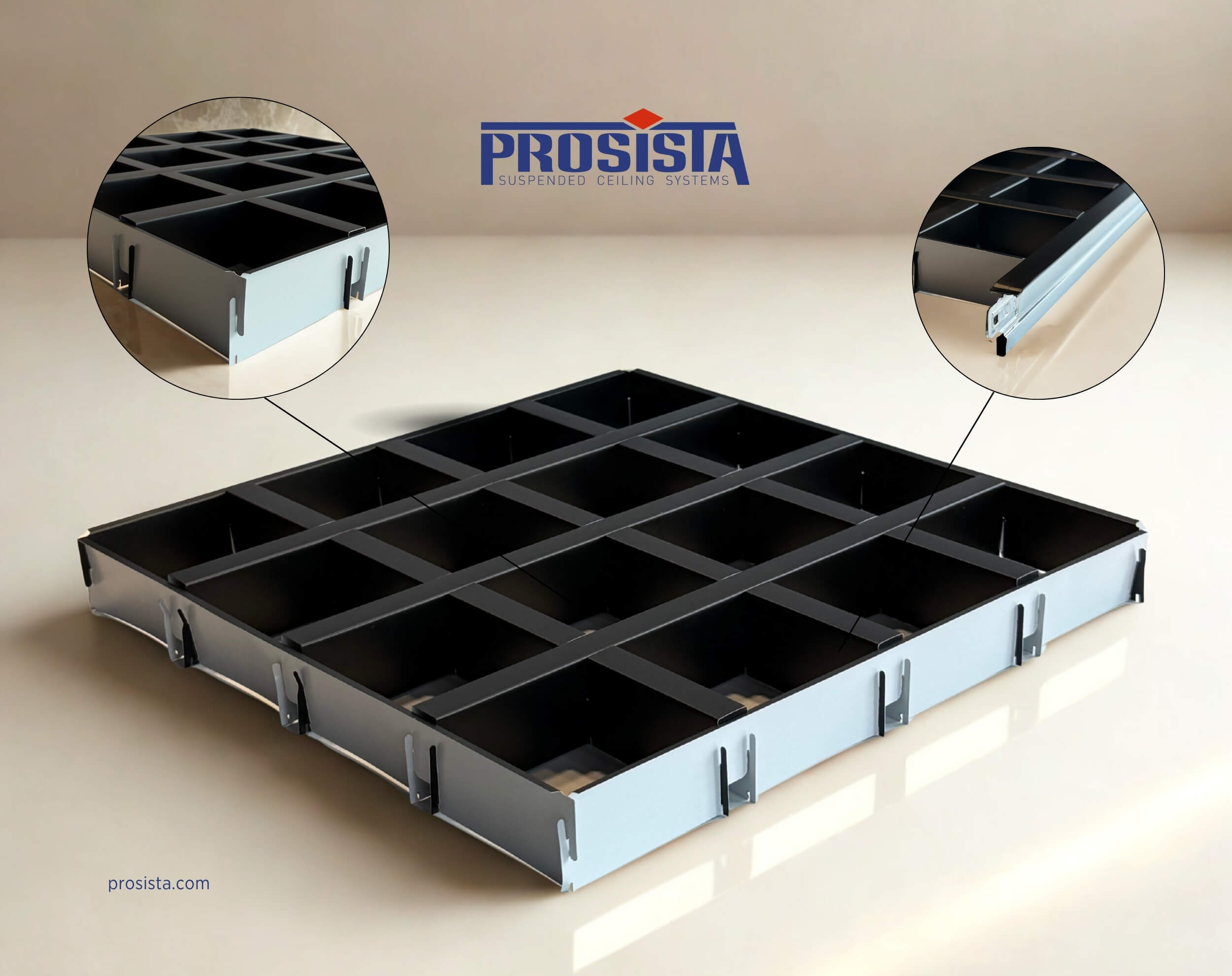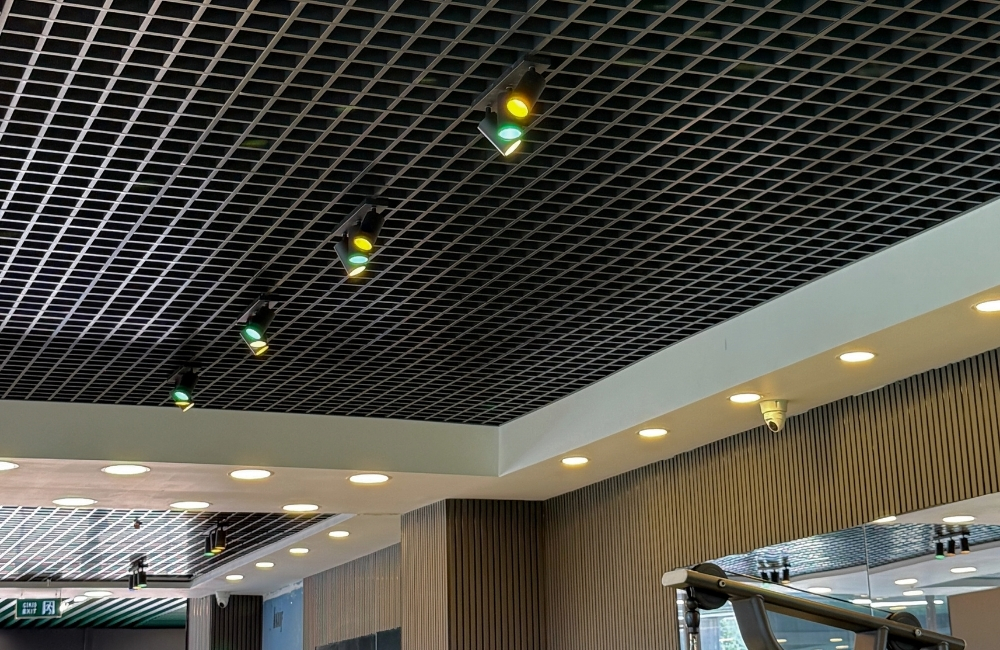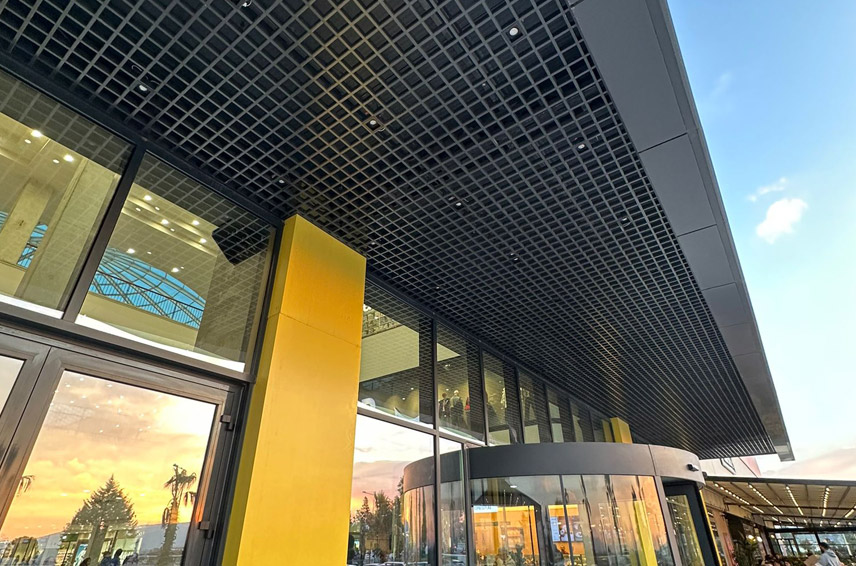The Ceiling’s Identity: Balancing Color, Texture, and Form
Introduction
In architectural projects, suspended ceilings are one of the most critical elements defining a space’s character. In this context, open cell ceiling systems — commonly known as griliato ceiling— offer solutions that are not only functional but also highly aesthetic. Produced from aluminum ceiling or galvanized steel, these ceiling systems bring permeability, depth, and a clean graphic effect to the ceiling surface, making them a frequent choice in modern interior projects.
More than the modular structure
However, the architectural success of such ceilings does not rely solely on the modular structure or rhythmic form. The true impact comes from the harmony between components, the integration of the suspension system, and especially the consistency of color tones.
What is an open cell ceiling?
An open cell suspended ceiling is a type of ceiling composed of aluminum profiles, resembling a cellular structure, that allows the passage of light and air. Usually manufactured in a grid pattern, it creates a rhythmic, orderly, and lightweight visual surface when viewed from below. Open cell ceilings are divided into several types, such as lamina open cell ceilings, self-carrying open cell ceilings, pyramid open cell ceilings, and T15 open cell ceiling systems.
Since each project has different architectural requirements, other suspended ceiling solutions — such as baffle, clip-in, linear, or mesh ceiling systems — should also be considered.
Surface unity: ıntegrating the carrier with the module
The primary strength of open cell ceiling systems lies in the seamless surface effect and visual lightness they create. To preserve this effect, it is essential that the carrier profiles — especially T10 or T15 carriers — fit perfectly into the modular structure, both technically flawless and visually discreet.
If the suspension system is not integrated into the surface design:
• Transitions between modules appear disconnected,
• Carrier lines become visible,
• The perception of a “single-piece surface” is disrupted,
• The simplicity of the space is lost, and visual clutter occurs.
In large interior spaces, such flaws are easily perceived. Therefore, aligning the carrier perfectly with the lamella and ensuring both share the same surface characteristics is not just a detail — it is an architectural necessity.

Color harmony: the ceiling’s subtle but powerful language
What leaves a lasting impression on the user is the harmony of color tones and the uniformity of the surface.
Achieving true harmony involves more than simply using the same RAL code. It requires the consistent interplay of:
• The exact shade of paint,
• The level of gloss or matte finish,
• The surface texture,
• The way the surface reacts to light.

What happens if the carrier and the module (lamella) are different colors?
One of the most common mistakes regarding color tone consistency is using different colors for the carrier system and the module (lamella).
When this happens:
• The surface appears visually segmented,
• The carrier system becomes visible as linear patterns,
• The rhythmic nature of the open cell design is disrupted, creating a form of “graphic noise,”
• Light reflects differently, and shadows create unwanted contrasts.
This issue becomes even more apparent in strong tones such as black, white, or anthracite open cell ceilings. Even with the same RAL code, differences in manufacturing processes can lead to variations in texture and gloss, and these small deviations can disturb the overall uniformity of the surface.
Correct application: consistency in color and texture
In a successful open cell ceiling installation, all components — the carrier, the open cell modules, and the ceiling accessories — should be selected with the same color tone and the same surface characteristics. This is not only an aesthetic concern but also a critical detail for the perception of quality, the sense of calmness in the space, and overall visual coherence.
In self-supporting open cell systems or T15 carrier systems, color harmony becomes even more crucial since the carrier has a visible linear role in the surface. Perfectly integrating the carrier with the module surface transforms the ceiling into a “strong architectural backdrop.”
Conclusion: the ceiling – the silent narrator of ınteriors
Open cell ceiling systems, despite their simple appearance, are modern architectural solutions that require detailed engineering and high application precision. Alignment between modules and the carrier system, color tone consistency, and seamless texture transitions are subtle details that form the architectural foundation of the atmosphere the modular ceiling brings to the space.
These fine details are recognized and executed correctly only by expert teams who value quality and precision in their work. For us, the goal is not just to build a modular suspended ceiling but to create architectural ceiling solutions that reflect the character of the space and deliver perfect visual unity.
? For more information, product details, and technical drawings:
https://www.prosista.com/en/category/open-cell-ceiling
? Reference project:
Prosista Open Cell Ceiling Application – S Dental
➡ In this project, a T15 anthracite open cell ceiling system was used, achieving perfect harmony between carrier and module in both color and form, resulting in complete surface unity.
https://www.prosista.com/en/reference/s-dental



